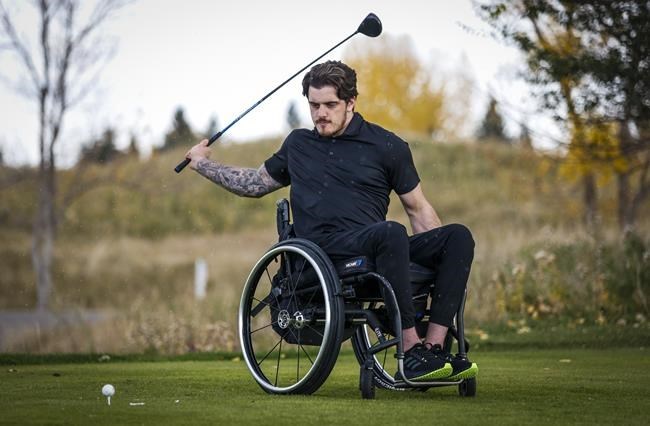CALGARY — Three years after the Humboldt Broncos bus crash claimed the lives of 11 of his teammates, Ryan Straschnitzki is well on his way to reaching a major goal — the ability to live an independent life.
Straschnitzki, who is now 22, was paralyzed from the chest down on April 6, 2018, when a semi-trailer ran a stop sign and went into the path of the junior hockey team's bus in rural Saskatchewan.
In total, sixteen people died and 13 others were seriously injured.
Straschnitzki, who lives in Airdrie, just north of Calgary, has set his goals on playing on the national sledge hockey team at the Olympics, being able to walk again some day and caring for himself.
Last week, he drove up to his physiotherapy appointment, took out his wheelchair from his car, snapped on its wheels and was in the building in less than a minute. He often travels alone.
Later in the day, he went for a paragolf lesson,which he started earlier in September.
"One of my goals from the start was to be more independent and do more things for myself … for the time that I am living by myself or doing things for myself," Straschnitzki said while at Calgary's Heritage Pointe Golf Club.
"I'm going to be able to do it and manage adversity if something was to happen."
During the gruelling two-hour physio lesson, Straschnitzki used a walker and, with a little assistance, took about a dozen steps.
He has been working with a team from the Synaptic Neuro Rehabilitation Centre in Calgary and, two years ago in Thailand, had an epidural stimulator implanted in his spine. The device sends electrical currents to his spinal cord to try to stimulate nerves so he can move.
"I've got to get the stimulator reprogrammed and hopefully that can happen this year to make the stepping easier and more efficient," he said.
"But for now, yeah, it's a lot of walking and standing so I can be more independent and do it on my own."
On the golf course, Straschnitzki clutched his grandfather's driver. With one arm, he hit a ball more than 100 yards down the course.
He used to play golf before the crash.
"I love the feeling and it's something I want to get back in to," he said. "I went out to the driving range a couple of weeks ago and I was just smoking the ball.
"I'm just doing what I want to do and trying to better myself. And if people can take inspiration from that, then that's fantastic."
His golf instructor, Kiefer Jones, has been impressed with Straschnitzki's progress.
"He's hitting drives and hitting them straight, hitting them long," said Jones, who is legally blind.
"It was just so awesome that I wanted to be a part of it, so here we are, second lesson and I'm already seeing improvement."
Tom and Michelle Straschnitzki are amazed at their son's progress but said he often doesn't share his achievements.
"He's doing all kinds of things for himself. He barely wants me even around, so that's a good thing for him," Michelle Straschnitzki said with a laugh.
"Someday we're not going to be here and he needs to know he can do it for himself."
She became emotional when thinking back to her son's first day in the hospital after the crash.
"I still remember, like it was yesterday, the scream he made when they sat him up in the hospital in Saskatoon," she said.
"It still haunts me. But moments like this take a little bit of it away. Bit by bit."
This report by The Canadian Press was first published Oct. 4, 2021.
Bill Graveland, The Canadian Press



